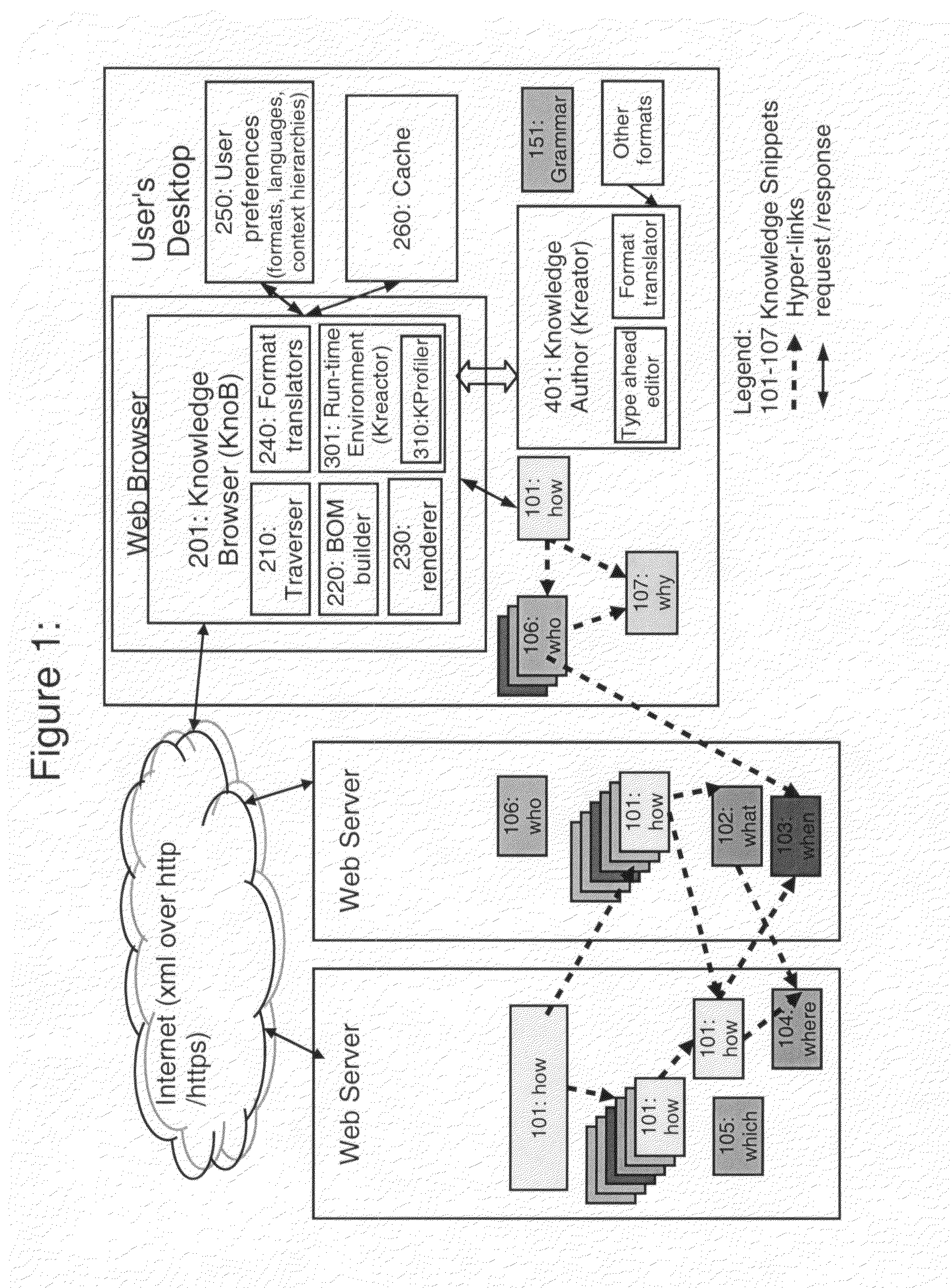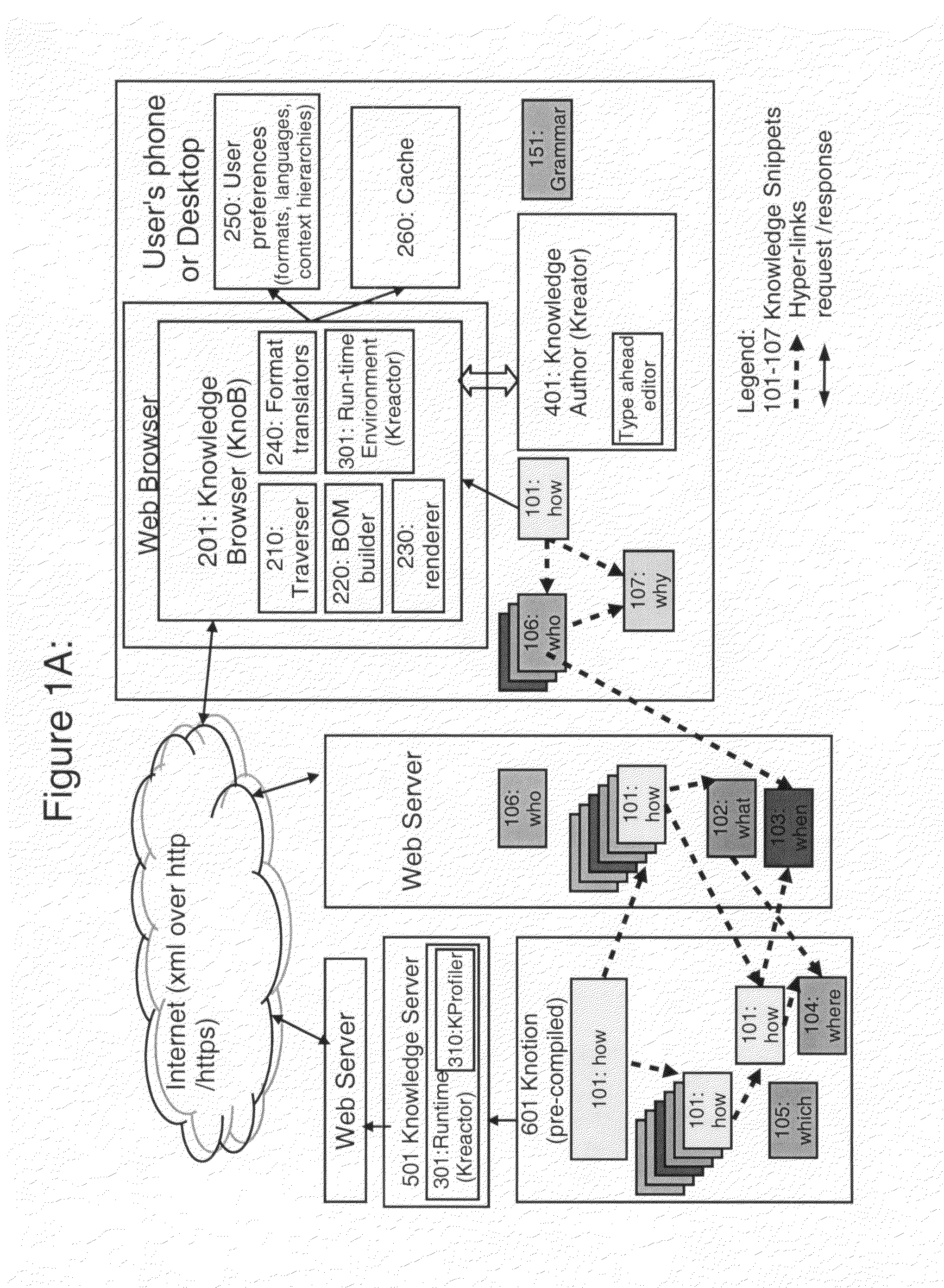Computer knowledge representation format, system, methods, and applications
a knowledge representation and computer technology, applied in the field of knowledge representation, can solve the problems of increasing the number of skill sets required to build software, the difficulty of full time software experts to keep up with all the disparate technologies, and the difficulty of non-technical persons to make computers “work”
- Summary
- Abstract
- Description
- Claims
- Application Information
AI Technical Summary
Problems solved by technology
Method used
Image
Examples
embodiment
Preferred Embodiment
[0199]An example of a grammar 151 (in FIG. 1 and FIG. 1A) of the preferred embodiment of this format is given in the DTD (Document Type Definition) file in the listings that are included on the attached CD.
[0200]Knowledge snippets can be one of the following types:
[0201]“.how”101: This is indicated by a file name suffix .how and is also indicated in the xml. This is mainly used to indicate how something is done i.e, a set of tasks to do something indicated by the phrase or word that is the filename prefix. The “how” snippet also comprises of looping and branching constructs which control the flow of the tasks. See FIG. 9 for a representation of what is “how”, in this format.
[0202]“.what”102: This is indicated by a file name suffix .what and is also indicated in the xml. This is mainly used to describe the word or phrase which is the file name of the knowledge snippet. It also details any sub components of the what. For example an automobile.what “” knowledge snip...
embodiment — figs
Alternative Embodiment—FIGS
[0253]While the a few embodiments are shown in the examples and figures, there are many other embodiments possible. One such embodiment is to use any Verb-Noun constructs (Verb for “how” knowledge snippet and Noun for “what”, “who” and “where” knowledge snippets) to represent knowledge.
[0254]The significant benefit of this invention is that many different embodiments of knowledge can be instantly derived by mixing and matching any components represented in this format and partitioning the knowledge snippets at deploy time to suit the specific need.
[0255]FIG. 1A shows an alternate embodiment where the Knob 201 is deployed in a User's phone or a desktop. Given it is potentially a smaller device, some of the components are not included here; specifically the Kprofiler 310 and a format translator in the Kreator 401. But it is supported externally by a knowledge server 501 with its run time environment (Kreactor 301) and Kprofiler 310 somewhere on the web. The ...
representation example
[0274]One of the many ways “Mary had a little lamb” could be marked up is as follows:
[0275]“Mary” hyper-linked to “Mary.who.xml” which answers who is the Mary in this context,
[0276]“had” hyper-linked to “had.how.xml” which answers how she “had”? alternatively “had” could also point directly to possess.how.xml Or eat.how.xml depending upon the context.
[0277]“a little lamb” hyper-linked to “a_little_lamb.what.xml” which answers what is meant by a little Iamb. In another context, each of the words in the fragment “a little lamb” might have pointed to a different snippet.
[0278]In this example there could have been multiple meanings to that sentence, but these hyper-links enables the author to point his / her communication to the correct unambiguous interpretations to each of these words or phrases.
PUM
 Login to View More
Login to View More Abstract
Description
Claims
Application Information
 Login to View More
Login to View More - R&D
- Intellectual Property
- Life Sciences
- Materials
- Tech Scout
- Unparalleled Data Quality
- Higher Quality Content
- 60% Fewer Hallucinations
Browse by: Latest US Patents, China's latest patents, Technical Efficacy Thesaurus, Application Domain, Technology Topic, Popular Technical Reports.
© 2025 PatSnap. All rights reserved.Legal|Privacy policy|Modern Slavery Act Transparency Statement|Sitemap|About US| Contact US: help@patsnap.com



